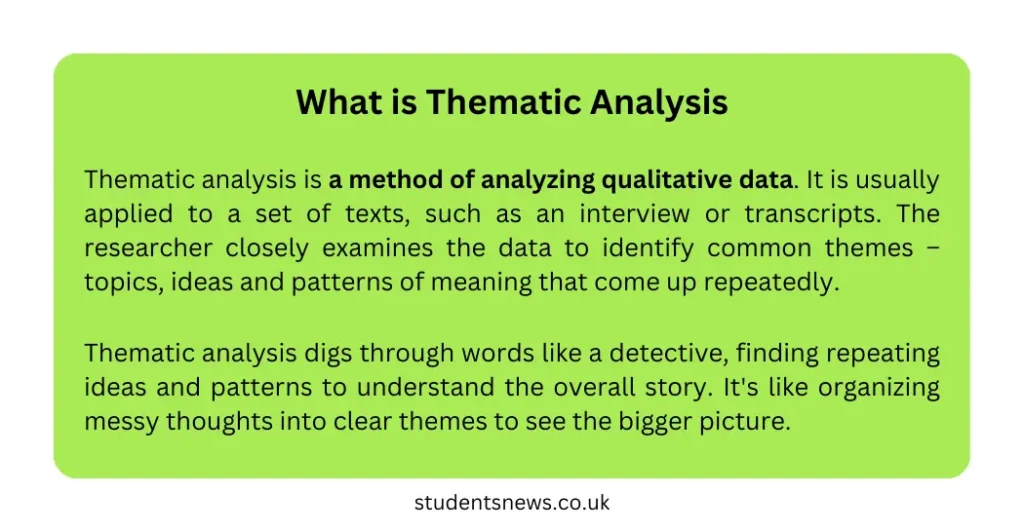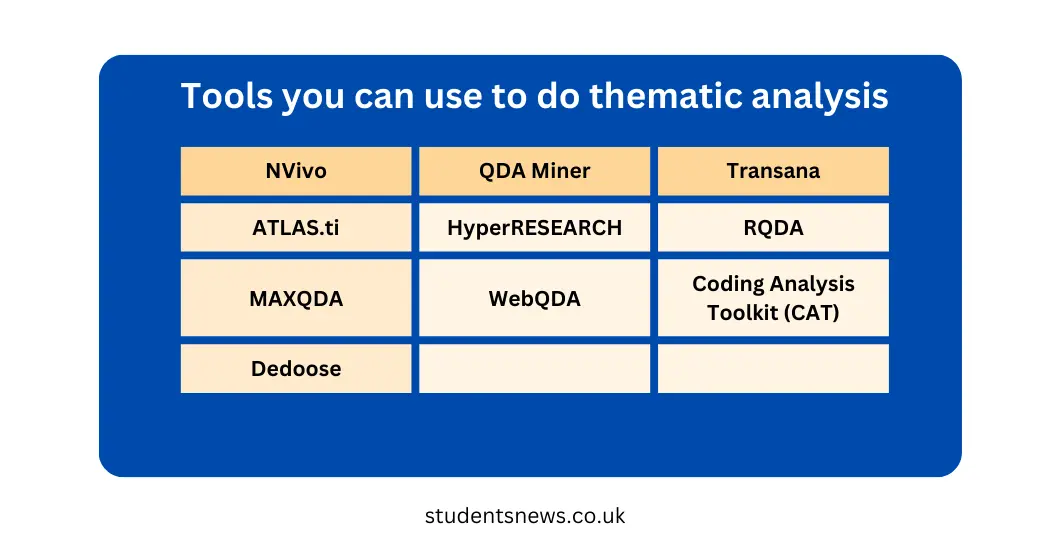Thematic analysis is a qualitative research method used to identify, analyze, and report patterns (themes) within data. In terms of approach, thematic analysis has two main types which are inductive and deductive thematic analysis. There are many advantages and disadvantages of thematic analysis that should be considered.
There are several tools and approaches that researchers may use for thematic analysis. Here are some commonly used thematic analysis tools:

Traditional Methods and Basic Tools
-
Pen-and-Paper Method: This traditional approach involves manually reading through data, highlighting relevant sections, and organizing them into themes. It’s a fundamental method that requires careful attention to detail but lacks the efficiency of digital tools.
-
Excel or Spreadsheet Software: Researchers often use spreadsheet software like Excel to organize and code data manually. Each row might represent a participant or text segment, with columns used for coding or categorization. While basic, it provides a structured approach for thematic analysis.
Advanced Software for Thematic Analysis
-
Coding Software: Advanced qualitative data analysis software such as NVivo, MAXQDA, and ATLAS.ti offer robust tools for thematic analysis. These tools allow researchers to code and organize data electronically, facilitating the identification and analysis of themes across large datasets. They also support various data formats, making them versatile for different research methodologies.
-
Dedoose: Dedoose is a web-based application specifically designed for qualitative and mixed-methods research. It provides collaborative tools for coding, exploring, and analyzing qualitative data online, making it ideal for research teams working remotely or across different locations.
Specialized Tools and Techniques
-
Word Cloud Generators: Tools like Wordle or Voyant create visual representations of word frequency in a dataset. While not traditional thematic analysis tools, they help researchers identify prominent terms or concepts that could serve as initial themes.
-
Mind Mapping Tools: Mind mapping software such as XMind or MindMeister aids researchers in visually organizing and connecting themes. This approach enhances the exploration of relationships within the data, supporting a more holistic thematic analysis process.
Open-Source and Free Tools
-
QDA Miner: QDA Miner is a qualitative data analysis tool that assists in coding, categorizing, and analyzing text data. It supports various data formats and offers visualization options, making it a cost-effective choice for researchers on a budget.
-
RQDA (R Qualitative Data Analysis): RQDA is an open-source software package for qualitative data analysis built on the R programming language. It provides a range of tools for coding, categorizing, and exploring textual data, making it highly customizable for advanced users.
Coding Frameworks and Manuals
-
Coding Frameworks: Researchers often develop coding frameworks or matrices to guide thematic analysis. These frameworks provide a structured set of codes and themes based on research objectives, ensuring consistency and reliability in the analysis process.
-
Coding Manuals: Manuals are essential documents that outline coding procedures and definitions for each code or theme. They help maintain consistency across the analysis and serve as a reference for researchers throughout the thematic coding process.
Choosing the Right Thematic Analysis Tool
Selecting the appropriate thematic analysis tool depends on several factors, including the nature of your research, the complexity of your data, and your team’s collaborative needs. Here’s a detailed exploration of considerations and recommendations for different types of tools:
Factors to Consider
-
Nature of Data: Consider the type of qualitative data you’re analyzing—interview transcripts, focus group discussions, open-ended survey responses, etc. Some tools are better suited for handling specific data formats or multimedia content.
-
Research Objectives: Clarify your research goals and the level of depth required in thematic analysis. Tools vary in their capabilities for coding complexity, data visualization, and integrating theoretical frameworks.
-
Team Collaboration: If you’re working in a team, assess tools that offer collaborative features such as shared coding projects, real-time updates, and access controls. This ensures seamless teamwork and enhances project management efficiency.
Recommendations Based on Needs
-
For Beginner Researchers: Start with user-friendly tools like NVivo or Dedoose, which provide intuitive interfaces and comprehensive tutorials. These tools simplify the coding process and offer built-in support for beginners.
-
For Advanced Analysis: Opt for MAXQDA or ATLAS.ti if your research demands sophisticated analysis techniques, such as advanced querying, network analysis, or multimedia integration. These tools cater to complex data structures and extensive coding frameworks.
-
For Budget-Conscious Researchers: Consider free or open-source options like QDA Miner or RQDA, which provide essential functionalities without licensing costs. These tools are suitable for smaller-scale projects or researchers exploring qualitative analysis methods.
Tool Integration and Support
-
Data Compatibility: Ensure the tool supports the file formats used in your research, including audio, video, and textual data. Compatibility ensures seamless data import and integration into the analysis workflow.
-
Training and Support: Evaluate the availability of training resources, online tutorials, and customer support provided by the tool’s developers. Strong support infrastructure can significantly reduce learning curves and troubleshooting time.
Practical Applications
Thematic analysis tools are applied across various fields of research, each demonstrating unique applications and outcomes. Here are practical examples showcasing how researchers utilize thematic analysis tools to uncover insights and inform qualitative research:
Case Study 1: Educational Research
Researchers in educational psychology use NVivo to analyze qualitative data from student interviews regarding learning behaviors. By coding themes related to motivation, engagement, and learning outcomes, researchers identify factors influencing academic performance and propose interventions.
Case Study 2: Healthcare Studies
In healthcare research, MAXQDA is employed to analyze patient narratives about chronic illness management. Themes such as patient empowerment, treatment adherence challenges, and healthcare provider communication are identified through systematic coding, guiding improvements in patient care strategies.
Case Study 3: Social Sciences
Social scientists use Dedoose for collaborative thematic analysis of focus group discussions on community perceptions of environmental policies. By coding themes related to environmental awareness, policy effectiveness, and community engagement, researchers inform policy recommendations and community outreach strategies.
Benefits and Insights
-
Insight Generation: Thematic analysis tools enable researchers to uncover nuanced insights and patterns within qualitative data, informing theory development and evidence-based practices.
-
Cross-disciplinary Applications: From psychology to sociology and beyond, thematic analysis tools support diverse research disciplines in exploring complex human experiences and phenomena.
-
Enhanced Research Rigor: By systematically organizing and interpreting qualitative data, researchers uphold methodological rigor and ensure findings are grounded in empirical evidence.



[…] providing insights into the underlying meaning and patterns within the qualitative information using many tools. There are two different types of thematic analysis which […]
[…] more about Thematic Analysis Tools to broaden your knowledge of […]
[…] This theme covers the use of technology in remote work, including the adaptation to new tools and methods. […]